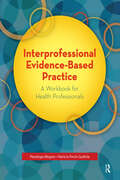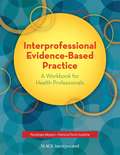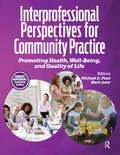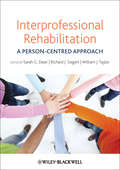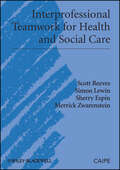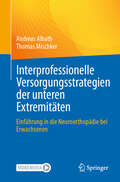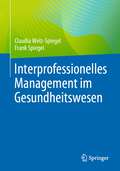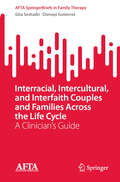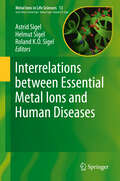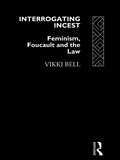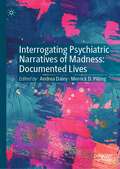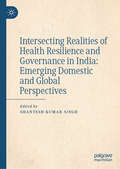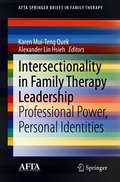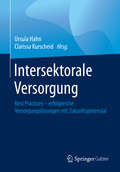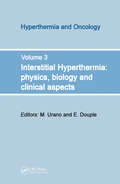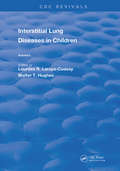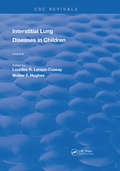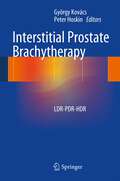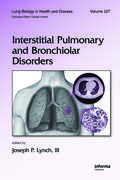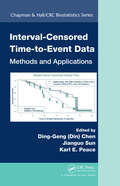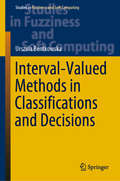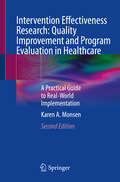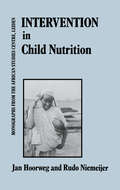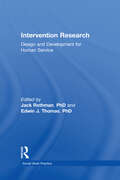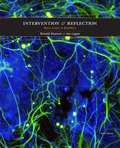- Table View
- List View
Interprofessional Evidence-Based Practice: A Workbook for Health Professionals
by Penelope Moyers Patricia Finch-GuthrieInterprofessional Evidence-Based Practice: A Workbook for Health Professionals promotes active, team learning of interprofessional evidence-based practice (EBP). This book is distinctive in that it departs from the tradition of evidence-based practice occurring from a single disciplinary perspective. Interprofessional evidence-based practice is described in terms of a dynamic team process that blends the patient’s preferences and values, the expertise of practitioners from multiple disciplines, and incorporates multidisciplinary evidence. Teams learn to use the nine phases in the interprofessional process to challenge current disciplinary paradigms and biases to create an integrated approach to patient care, healthcare delivery, or population health.Drs. Penelope Moyers and Patricia Finch Guthrie focus on developing and fostering collaboration between academic institutions and healthcare organizations so that students and faculty participate on interprofessional teams with mentors and staff from a healthcare organization. Interprofessional Evidence-Based Practice: A Workbook for Health Professionals also addresses the communication and cross-organizational factors important for supporting the work of the team. Common team and mentoring issues encountered in EBP are clearly articulated, along with the iterative problem-solving approaches necessary to mitigate temporary “stumbling blocks.”The book provides detail for developing and launching an Interprofessional Evidence-Based Practice program that goes beyond the evidence process to include implementation science to support practice change. Approaches for developing partnerships for supporting this type of program between universities and health care institutions are contained within, including sample partnership agreements and resource-sharing strategies.Inside Interprofessional Evidence-Based Practice: A Workbook for Health Professionals, each chapter includes performance objectives, key words, checklists, and materials and resources that an interprofessional team can use. PowerPoint lectures, mentor newsletters, forms, tools, and other resources are included on a companion website to guide team learning about key EBP topics, as well as to support the program coordinators and team mentors in their work with the interprofessional teams.Interprofessional Evidence-Based Practice: A Workbook for Health Professionals is the go-to resource for those who want to engage in interprofessional evidence-based practice, and for leaders who want to develop and implement an interprofessional evidence-based practice program.
Interprofessional Evidence-Based Practice: A Workbook for Health Professionals
by Penelope A. Moyers Patricia L. Finch-GuthrieInterprofessional Evidence-Based Practice: A Workbook for Health Professionals promotes active, team learning of interprofessional evidence-based practice (EBP). The book provides detail for developing and launching an Interprofessional Evidence-Based Practice program that goes beyond the evidence process to include implementation science to support practice change. Approaches for developing partnerships for supporting this type of program between universities and health care institutions are contained within, including sample partnership agreements and resource-sharing strategies. Each chapter includes performance objectives, key words, checklists, and materials and resources that an interprofessional team can use.
Interprofessional Perspectives for Community Practice: Promoting Health, Well-Being, and Quality of Life
by Michael Pizzi Mark AmirNow more than ever health care professionals play an increased role in the promotion of health to populations. Unique and innovative, Interprofessional Perspectives for Community Practice: Promoting Health, Well-being and Quality of Life weaves everyday care into prevention, community, and population health, creating a new and more expansive vision of health for all without compromising traditional practices.Authors and editors Drs. Pizzi and Amir discuss and illustrate a client-centered preventive and health, well-being and quality of life approach rooted in best practice principles from interprofessional literature and firsthand experience. The text illustrates how allied health professionals implement those principles in their everyday and traditional practices with an emphasis on exploring health and well-being issues. Interprofessional Perspectives for Community Practice provides detailed guidance in program development and implementation.What’s included in Interprofessional Perspectives for Community: Clinical anecdotes on successful community practices A focus on primary and secondary prevention Assessments, interventions, and community practice examples Descriptions of community-based practice settings such as adult day care, independent living programs, hospice, and home health care Health and wellness across the lifespan Bonus chapters available online as PDFs for readers The first text of its kind to weave interprofessionalism, community practice, and health, well-being, and quality of life, Interprofessional Perspectives for Community Practice: Promoting Health, Well-being and Quality of Life is for all health care workers and students who wish to transfer practice skills from the clinical setting to a population-based program development model.
Interprofessional Rehabilitation
by William J. Taylor Sarah G. Dean Richard J. SiegertInterprofessional Rehabilitation: a Person-Centred Approach is a concise and readable introduction to the principles and practice of a person-centred interprofessional approach to rehabilitation, based upon a firm scientific evidence base.Written by a multi-contributor team of specialists in physiotherapy, occupational therapy, nursing, psychology and rehabilitation medicine, this text draws together common themes that cut across the different professional groups and the spectrum of health conditions requiring rehabilitation, and sets out a model of practice that is tailored to the specific needs of the client. Showing interprofessionalism at work in a range of clinical contexts, the book argues that effective rehabilitation is best conducted by well-integrated teams of specialists working in an interdisciplinary way, with the client or patient actively involved in all stages of the process.This book will be essential reading for students preparing for practice in an increasingly interprofessional environment, and will be of interest to any health care practitioner keen to understand how an integrated approach to rehabilitation can benefit their clients.
Interprofessional Teamwork for Health and Social Care (Promoting Partnership for Health #8)
by Simon Lewin Sherry Espin Scott Reeves Merrick ZwarensteinPROMOTING PARTNERSHIP FOR HEALTH This book forms part of a series entitled Promoting Partnership for Health publishedin association with the UK Centre for the Advancement of Interprofessional Education (CAIPE). The series explores partnership for health from policy, practice and educational perspectives. Whilst strongly advocating the imperative driving collaboration in healthcare, it adopts a pragmatic approach. Far from accepting established ideas and approaches, the series alerts readers to the pitfalls and ways to avoid them. DESCRIPTION Interprofessional Teamwork for Health and Social Care is an invaluable guide for clinicians, academics, managers and policymakers who need to understand, implement and evaluate interprofessional teamwork. It will give them a fuller understanding of how teams function, of the issues relating to the evaluation of teamwork, and of approaches to creating and implementing interventions (e.g. team training, quality improvement initiatives) within health and social care settings. It will also raise awareness of the wide range of theories that can inform interprofessional teamwork. The book is divided into nine chapters. The first 'sets the scene' by outlining some common issues which underpin interprofessional teamwork, while the second discusses current teamwork developments around the globe. Chapter 3 explores a range of team concepts, and Chapter 4 offers a new framework for understanding interprofessional teamwork. The next three chapters discuss how a range of range of social science theories, interventions and evaluation approaches can be employed to advance this field. Chapter 8 presents a synthesis of research into teams the authors have undertaken in Canada, South Africa and the UK, while the final chapter draws together key threads and offers ideas for future of teamwork. The book also provides a range of resources for designing, implementing and evaluating interprofessional teamwork activities.
Interprofessionelle Versorgungsstrategien der unteren Extremitäten: Einführung in die Neuroorthopädie bei Erwachsenen
by Andreas Albath Thomas MischkerDieses Praxisbuch behandelt viele Facetten der Befundung und Behandlung von neuroorthopädischen Gangstörungen in den Bereichen Physiotherapie, Ergotherapie und Orthopädietechnik. Es verbindet geschickt die neurophysiologischen Grundlagen mit therapeutischen Interventionsmöglichkeiten und orthopädietechnischen Ansätzen. Durch verständliche Erläuterungen biomechanischer Zusammenhänge sowie grundlegender therapeutischer Prinzipien wird das Verständnis erleichtert und die Anwendung im interdisziplinären Team gestärkt. Aus dem Inhalt: Systeme und Strukturen für die sensomotorische Kontrolle, Physiologischer Gang und Gangphasen, Assessments, Therapie, Behandlungskonzepte und Evaluation, Häufige Gangstörungen in der Neurologie und Neuroorthopädie, Orthopädietechnische Grundlagen und Orthesenversorgung, Plus: Befund und Assessment zum Download.
Interprofessionelles Management im Gesundheitswesen
by Frank Spiegel Claudia Welz-SpiegelInterprofessionelle Zusammenarbeit prägt das Gesundheitswesen der Zukunft. Gemeinsam auf Augenhöhe erfolgreich sein, muss das Handlungsprinzip unterschiedlicher Berufsgruppen sein. Dies erfordert eine gut abgestimmte interprofessionelle Zusammenarbeit, den Einsatz geeigneter Methoden und das Management komplexer Prozesse.Dieses Lehrbuch behandelt theoretische Zusammenhänge umfassend und systematisch. Es zeigt Möglichkeiten auf, interprofessionelle Teams zu leiten und erfolgreich zu gestalten. Dabei legt das Buch großen Wert auf methodisches, praxisnahes Handeln und verliert sich nicht in abstrakten Ideen. Arbeitsmethoden, Führungsverhalten und -modelle werden lösungsorientiert erläutert. Auch neue Ansätze, wie die laterale Führung und die Rolle des interprofessionellen Managers sind Teil des Inhalts.Das Buch richtet sich an Studierende, Projekt- und Teamleiter, Verantwortliche von interprofessionellen Teams und Qualitäts- und Risikomanager. Ziel ist, die eigene Rolle zu stärken und die Managementkompetenz zu unterstützen.Zu den vielfältigen Anwendungsgebieten zählen:Management und Führung interprofessioneller Teams im klinischen Alltag, in der Qualitätsentwicklung, im Prozessmanagement, Changemanagement, Konfliktmanagement und im Risikomanagement. Sprich im täglichen Miteinander der Berufsgruppen.
Interracial, Intercultural, and Interfaith Couples and Families Across the Life Cycle: A Clinician’s Guide (AFTA SpringerBriefs in Family Therapy)
by Gita Seshadri Dumayi GutierrezThis book examines issues of intersectionality and multicultural competency, humility, and sensitivity necessary to work with interracial, intercultural, and interfaith couples. It describes a therapeutic approach that combines a social constructionist framework with ecological systems theory using an intersectional lens. Chapters explore key issues relevant to interracial, intercultural, and interfaith couples across the lifespan, including attraction and dating, cohabitation, marriage and polyamory, children, retirement as well as such potentially challenging topics as sex, politics, and religion. Featured areas of coverage include: How to apply ecological systems theory and social constructionism to guide self of the therapist reflections and clinical interventions that address the nuances of intersectionality among interracial, intercultural, and interfaith couples across the lifespan. Attention to intersectionality between therapists and clients. Strategies for addressing challenging issues within the current political environment in which diversity is debated and may become divisive. Case applications and extended reflections Interracial, Intercultural, and Interfaith Couples and Families Across the Life Cycle: A Clinician’s Guide is an essential resource for clinicians, therapists, and practitioners as well as researchers, professors, and graduate students in family studies, clinical psychology, and public health, as well as all interrelated disciplines.
Interrelations between Essential Metal Ions and Human Diseases
by Astrid Sigel Helmut Sigel Roland K. O. SigelMILS-13 provides an up-to-date review on the relationships between essential metals and human diseases, covering 13 metals and 3 metalloids: The bulk metals sodium, potassium, magnesium, and calcium, plus the trace elements manganese, iron, cobalt, copper, zinc, molybdenum, and selenium, all of which are essential for life. Also covered are chromium, vanadium, nickel, silicon, and arsenic, which have been proposed as being essential for humans in the 2nd half of the last century. However, if at all, they are needed only in ultra-trace amounts, and because of their prevalence in the environment, it has been difficult to prove whether or not they are required. In any case, all these elements are toxic in higher concentrations and therefore, transport and cellular concentrations of at least the essential ones, are tightly controlled; hence, their homeostasis and role for life, including deficiency or overload, and their links to illnesses, including cancer and neurological disorders, are thoroughly discussed. Indeed, it is an old wisdom that metals are indispensable for life. Therefore, Volume 13 provides in an authoritative and timely manner in 16 stimulating chapters, written by 29 internationally recognized experts from 7 nations, and supported by more than 2750 references, and over 20 tables and 80 illustrations, many in color, a most up-to-date view on the vibrant research area of the Interrelations between Essential Metal Ions and Human Diseases.
Interrogating Incest: Feminism, Foucault and the Law (Sociology of Law and Crime)
by Vikki BellWinner of British Sociological Association Philip Abrams Memorial Prize 1993 Within feminism incest has often been subsumed under a discussion of sexual violence and abuse. Yet, important as this is, there has been little account of how feminist work itself relates to other ways of talking about and understanding incest.In Interrogating Incest Vikki Bell focuses on the issue of incest and its place in sociological theory, feminist theory and criminal law. By examining incest from a critical Foucauldian framework she considers how feminist discourse on incest itself fits into existing ways of talking about sex. Closely surveying the historical background to incest legislation and the theoretical issues involve, Vikki Bell delineates their practical implications and shows what uncomfortable questions and important dilemmas are raised by the criminalisation of incest.
Interrogating Psychiatric Narratives of Madness: Documented Lives
by Andrea Daley Merrick D. PillingThis book challenges the perception of the psychiatric chart as a neutral and objective text. The chapters included in this book coalesce to reveal the psychiatric chart as a text that is, in fact, “storied” by institutional ideology that reflects, reinforces, reinterprets, and, at times, resists gendered, raced, sexualized, and classed norms, values, and presuppositions. Intersectional analysis highlights the nuanced ways in which dominant ideologies are activated in chart documentation to produce qualitatively specific psychiatric narratives of distress and related responses in the psychiatric institution. The book serves as a much-needed resource for mental health professionals, education and training programs, and researchers that meaningfully takes into account the social and structural materiality of people’s lives and its impact on experiences of distress. It will also appeal to scholars investigating equity in health care across the fields of Critical Psychology, Disability Studies, Social Work, Allied Health, Mad Studies and Social Justice.
Intersecting Realities of Health Resilience and Governance in India: Emerging Domestic and Global Perspectives
by Shantesh Kumar SinghThe book delves into the intricate interplay between health resilience and governance in the context of India, providing a thorough examination of critical domestic and international issues. It examines the multifaceted challenges faced by India concerning the health of its populace, the impacts of nonconventional security concerns, and the effectiveness of governance mechanisms in addressing these issues. With a multidimensional lens, it analyses the convoluted connections between health outcomes and multiple factors, shedding light on the complex web of health risks. Moreover, it critically evaluates the existing governance frameworks in India, assessing their strengths and weaknesses in dealing with the complex domestic and international challenges posed by the intersection of health and other emerging nontraditional security issues. It synthesizes extensive research and empirical data, presenting a nuanced understanding of the current scenario and exploring innovative solutions and policy recommendations. This book investigates valuable domestic and international perspectives and provides insights to diplomats, foreign and domestic policymakers, researchers, and practitioners by addressing research gaps and understanding within the realms of health resilience and governance in India. It serves as a foundational resource for comprehending the dynamics of these issues in the Indian context, offering a roadmap for creating resilient, sustainable, and equitable policies that can safeguard public health amidst the domestic and international challenges of an evolving governance structures in India.
Intersectionality in Family Therapy Leadership: Professional Power, Personal Identities (AFTA SpringerBriefs in Family Therapy)
by Karen Mui-Teng Quek Alexander Lin HsiehThis brief examines the ways in which sociocultural characteristics and contexts intersect to create varying dimensions of social advantage and inequality that, in turn, affect and organize professional relationships in educational and therapeutic settings. It explores how inherently hierarchical relationships develop within educational and university contexts, including between professors and students, supervisors and supervisees, clinicians and clients, and administrators and faculty members. The volume addresses how participants’ social locations inform their roles and actions and how they can hold positions of power while also embodying a marginalized identities.In addition, the book draws on perspectives of persons marginalized or privileged based on their race/ethnicity, sexual orientation, and/or gender to examine how social location impacts their work as family therapy clinicians, supervisors, instructors, and administrators. Grounded in individual reflection and detailed experiences, each chapter describes rich personal narrative on how the individual therapist’s intersecting social locations influence his/her professional relationships. This book highlights the need for family therapists to identify their social location characteristics, evaluate the impact of their social location on their professional relationships, and process the role social location has on their academic, supervisory and clinical position. This volume is an essential resource for clinicians and practitioners, researchers and professors, and graduate students in family studies, clinical psychology, and public health as well as all interrelated disciplines.
Intersektorale Versorgung: Best Practices – erfolgreiche Versorgungslösungen mit Zukunftspotenzial
by Ursula Hahn Clarissa KurscheidDas deutsche Gesundheitswesen ist ein sehr komplexes und hoch reguliertes Gebilde, geprägt durch eine historisch bedingte Sektorentrennung, eine staatsmittelbare Selbstverwaltung mit immer neuen Regulationen und Gesetzesreformen in zunehmend kürzeren Rhythmen. Zugleich zeichnet sich der erste Gesundheitsmarkt durch eine deutliche Geschlossenheit gegenüber Innovationen aus. Es ist einerseits schwierig, Neuerungen und sektorenübergreifende Versorgungsansätze zu implementieren, andererseits schaffen es viele gute Ideen und erfolgreiche Projekte nicht in die Regelversorgung. Doch knappe finanzielle Ressourcen, die demographische Entwicklung, die wachsenden medizinisch-technischen und digitalen Möglichkeiten sowie die interfachliche und interdisziplinäre Arbeitsteilung fordern geradezu neue intersektorale Ansätze. Tatsächlich gibt es trotz der Hürden gute und funktionierende intersektorale Lösungen. In diesem Herausgeberwerk werden knapp dreißig Best-Practice-Beispiele vorgestellt: Akteure ganz unterschiedlicher Provenienz berichten über ihre Lösungen, die von Kooperation verschiedener selbständiger Akteure bis Integration aller Versorgungsebenen unter einem Dach reichen. Dabei orientieren sie sich an Gütekriterien, wie z.B. Qualität der Patientenversorgung, Effizienzpotenziale, Skalierbarkeit oder Anforderungen an einen notwendigen Strukturwandel. Die Erfahrungen dieser Best-Practice-Beispiele können und sollen für die Weiterentwicklung einer modernen und patientenorientierten intersektoralen Versorgung nutzbar gemacht werden.
Interstitial Hyperthermia: Physics, Biology and Clinical Aspects
by M. Urano E. DoupleIn the last decade the use of interstitial microwave antennas to deliver localized and controlled power to deep-seated tumours has been explored in institutes around the world. Simultaneously the field of brachytherapy also progressed as clinicans began to develop new implantation approaches for a variety of tumour sites, thereby promoting the insertion of catheters which could serve as conduits for the insterstitial microwave applicators. Although the challenges presented by deep-seated tumours have not been solved, the developments in the field of brachytherapy and the implantation of interstitial applicators for hyperthermia are such that a volume dedicated to this approach is warranted. This third volume in the series "Hyperthermia and Oncology" provides insight in and updated information on various aspects of interstitial hyperthermia. It aims to serve as a guide for clinicians who are either already working in the field or who wish to implement this treatment. It also provides basic aspects to physicists and biologists who are interested in the field of hyperthermic treatment.
Interstitial Lung Diseases in Children: Volume 1 (Routledge Revivals)
by Lourdes R. Laraya-Cuasay Walter T. Hughes, Jr.First Published in 1988, Interstitial Lung Diseases in Children identifies, describes and offers insight into how to treat the vast array of lung diseases found in infants, children, and teenagers. Filled with clear and useful references, this book works best as a guide for Pediatricians and those with a keen interest in Medicine.
Interstitial Lung Diseases in Children: Volume 3 (Routledge Revivals)
by Lourdes R. Laraya-Cuasay Walter T. Hughes, Jr.First Published in 1988, Interstitial Lung Diseases in Children identifies, describes and offers insight into how to treat the vast array of lung diseases found in infants, children, and teenagers. Filled with clear and useful references, this book works best as a guide for Pediatricians and those with a keen interest in Medicine.
Interstitial Prostate Brachytherapy
by Peter Hoskin György KovácsProstate brachytherapy has been the subject of heated debate among surgeons and the proponents of the various brachytherapy methods. This very first interdisciplinary book on the subject provides a comprehensive overview of innovations in low dose rate (LDR), high dose rate (HDR), and pulsed dose rate (PDR) interstitial brachytherapy for the management of local or locally advanced prostate cancer. In addition to detailed chapters on patient selection and the use of imaging in diagnostics, treatment guidance, and implantation control, background chapters are included on related medical physics issues such as treatment planning and quality assurance. The results obtained with the different treatment options and the difficult task of salvage treatment are fully discussed. All chapters have been written by internationally recognized experts who for more than a decade have formed the teaching staff responsible for the successful GEC-ESTRO/EAU Prostate Brachytherapy Teaching Course.
Interstitial Pulmonary and Bronchiolar Disorders (Lung Biology in Health and Disease)
by Joseph P. LynchRemoving the guesswork associated with Interstitial Lung Disorders (ILDs) and bronchiolar disorders, Interstitial Pulmonary and Bronchiolar Disorders addresses the issues faced by pulmonologists in treating these disorders. Divided into sections based on the disease type (granulomatous, pneumonias, bronchiolar disorders, vasculitis, and orphan lung
Interval-Censored Time-to-Event Data: Methods and Applications (Chapman & Hall/CRC Biostatistics Series)
by Jianguo Sun Karl E. Peace Ding-GengInterval-Censored Time-to-Event Data: Methods and Applications collects the most recent techniques, models, and computational tools for interval-censored time-to-event data. Top biostatisticians from academia, biopharmaceutical industries, and government agencies discuss how these advances are impacting clinical trials and biomedical research.Divid
Interval-Valued Methods in Classifications and Decisions (Studies in Fuzziness and Soft Computing #378)
by Urszula BentkowskaThis book describes novel algorithms based on interval-valued fuzzy methods that are expected to improve classification and decision-making processes under incomplete or imprecise information. At first, it introduces interval-valued fuzzy sets. It then discusses new methods for aggregation on interval-valued settings, and the most common properties of interval-valued aggregation operators. It then presents applications such as decision making using interval-valued aggregation, and classification in case of missing values. Interesting applications of the developed algorithms to DNA microarray analysis and in medical decision support systems are shown. The book is intended not only as a timely report for the community working on fuzzy sets and their extensions but also for researchers and practitioners dealing with the problems of uncertain or imperfect information.
Intervention Effectiveness Research: A Practical Guide to Real-World Implementation
by Karen A. MonsenThis new edition provides a model and road map to answer clinical questions related to intervention effectiveness research, quality improvement, and program evaluation. It offers clear and simple guidance for all phases of a clinical inquiry projects from planning through dissemination and communication of results and findings. The book emphasizes the value and importance of leveraging existing data to advance research, practice, and quality improvement efforts. The new edition of Intervention Effectiveness Research is an updated practical guide for organizing and navigating the intersections of research and practice. Structure, process, and outcome worksheets for every step are provided together with examples from diverse settings and populations to lead readers through the process of implementing their own projects. The author highlights real world projects and clarifies interpretations from the differing perspectives of research, quality improvement,and program evaluation. This book is intended for teachers of DNP and PhD programs in nursing and other disciplines, their students, and healthcare leaders who need to leverage data to demonstrate care quality and outcomes.
Intervention In Child Nutrition
by HoorwegFirst published in 1989. Routledge is an imprint of Taylor & Francis, an informa company.
Intervention Research: Design and Development for Human Service
by Jack Rothman Edwin J ThomasThis interdisciplinary book presents a comprehensive conceptual and methodological treatment of intervention research, a developing area of empirical inquiry that aims to make research more directly relevant and applicable to practice. Intervention Research contains original chapters by the most highly regarded scholars in the field. These experts explain how to distinguish intervention research from other modalities, demonstrate a new model of research for the design and development of interventions, and provide guidelines for conducting intervention research in practice with individuals, families, and community organizations. Providing useful observations and a wealth of ideas, authors offer conceptual schemes, results from recent design and development studies, and strategies and methodologies to help professionals make their research more usable and meaningful. Chapters cover such important topics as the acquisition of relevant knowledge, meta-analysis in intervention research, methods and issues in designing and developing interventions, and field testing and evaluating innovative practice interventions. The book depicts intervention research through case illustrations and promotes the use of new technologies for developing innovative practice methods. Intervention Research focuses on Intervention Design and Development--the part of intervention research involving the creation of reliable, practical tools of social intervention in user-ready form. It sets forth systematic procedures for designing, testing, evaluating, and refining needed social technology and for disseminating proven techniques and programs to professionals in the community.Intervention Research has a base in social work, but is highly interdisciplinary. Authors contributing to this text come from a variety of fields, including psychology, sociology, education, information science, and communications. Professors and educators working in schools of public health, education, urban planning, nursing, and public administration, or teaching courses in psychology, sociology, or upper-level social work, will find this book full of comprehensive and practical information that is advantageous for their work.
Intervention and Reflection: Basic Issues in Bioethics
by Ronald MunsonThis 10th Edition offers students a compelling introduction to biomedical ethics by combining riveting human stories with clear explanations of cutting edge scientific research. A collaboration between a nationally-acclaimed bioethicist and a seasoned journalist, this textbook continues to be the most widely used bioethics textbook on the market. Each chapter includes crisp summaries of the relevant ethical theories as well as classic and contemporary articles on the most pressing topics in the field. This edition features new chapters on "Medicine in a Pluralistic Society" and the "Challenge of Global Bioethics. The accessible presentation of the conceptual debate and human dimension of today's biomedical ethics captivates and engages students, whether they are philosophy, nursing or medical majors or have no philosophical or scientific training.
